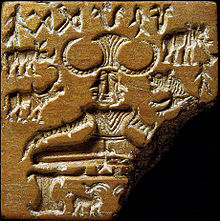A | B | C | D | E | F | G | H | CH | I | J | K | L | M | N | O | P | Q | R | S | T | U | V | W | X | Y | Z | 0 | 1 | 2 | 3 | 4 | 5 | 6 | 7 | 8 | 9
| Pashupati | |
|---|---|
Lord of the Animals | |
 | |
| Affiliation | Incarnation of Shiva |
| Region | Indian subcontinent |
| Part of a series on |
| Shaivism |
|---|
 |
|
|
Pashupati (Sanskrit Paśupati; devanagari पशुपति ) is a Hindu deity and an incarnation of the Hindu god Shiva as "lord of the animals". Pashupati is mainly worshipped in Nepal and India. Pashupati is also the national deity of Nepal.
History

The earliest claimed evidence of Pashupati comes from the Indus Valley civilization (3300 BCE to 1300 BCE), where the Pashupati seal has been said to represent a proto-Shiva figure.[1]
Etymology
Paśupati or Pashupatinath, means "Lord of all animals". It was originally an epithet of Rudra in the Vedic period.[2] Now it is one of the epithets of Shiva.[3]
The Deity
Pashupatinath is an avatar of Shiva, one of the Hindu Trinity. He is the male counterpart of Shakti.
The five faces of Pashupatinath represent various incarnations of Shiva; Sadyojata (also known as Barun), Vamdeva (also known as Uma Maheswara), Tatpurusha, Aghor & Ishana. They face West, North, East, South and Zenith respectively, representing Hinduism's five primary elements namely earth, water, air, light and ether.[4]
Puranas describe these faces of Shiva as:
Sadyojata, Vamdeva, Tatpurusha & Aghora are the four faces, The fifth is Ishana, unknowable even to the seers.[4]
By country
Nepal

Although Nepal is a secular state, its population is predominantly Hindu. Pashupatinath is revered as a national deity.[5] The Pashupatinath Temple, located at the bank of the river Bagmati, is considered one of the most sacred places in Nepal. In mythology it is said that Lord Pashupatinath started living in Nepal in the form of a deer because he was enchanted by the beauty of Kathmandu Valley.
India
A Pashupatinath temple is sited on the banks of the Shivana river in Mandsaur, Madhya Pradesh, India. It is one of the most important shrines of Mandsaur, and Lord Shiva in the form of Lord Pashupatinath is its primary deity. Its main attraction is a unique Shiva Linga displaying eight faces of Lord Shiva. The shrine has four doors, representing the cardinal directions.[6]
Pashupata Shaivism
Pashupata Shaivism is one of the oldest Shaivite sects that derives its name from Pashupati. The sect upholds Pashupati "as the supreme deity, the lord of all souls, and the cause of all existence".[7]
See also
References
- ^ Marshall Sir John (1931). Mohenjo Daro and the Indus Civilization Vol-i (1931).
- ^ Kramrisch, p. 479.
- ^ Śarmā 1996, p. 291.
- ^ a b Encyclopaedia of Saivism, Swami P. Anand, Swami Parmeshwaranand, Publisher Sarup & Sons, ISBN 8176254274, ISBN 9788176254274, page 206
- ^ Nepal - Culture Smart!: The Essential Guide to Customs & Culture, p.148, Kuperard
- ^ Pashupatinath Temple website Archived 2013-05-30 at the Wayback Machine
- ^ Hinduism: An Alphabetical Guide, p. 923, Roshen Dalal, Penguin UK
Sources
- Flood, Gavin (1996). An Introduction to Hinduism. Cambridge: Cambridge University Press. ISBN 0-521-43878-0.
- Flood, Gavin, ed. (2003). The Blackwell Companion to Hinduism. Malden, Massachusetts: Blackwell. ISBN 1-4051-3251-5.
- Kramrisch, Stella (1981). The Presence of Śiva. Princeton, New Jersey: Princeton University Press. ISBN 0-691-01930-4.
- Michaels, Axel (2004). Hinduism: Past and Present. Princeton, New Jersey: Princeton University Press. ISBN 0-691-08953-1.
- Possehl, Gregory (2003). The Indus Civilization: A Contemporary Perspective. AltaMira Press. ISBN 978-0-7591-0172-2.
- Śarmā, Rāmakaraṇa (1996). Śivasahasranāmāṣṭakam : eight collections of hymns containing one thousand and eight names of Śiva. Delhi: Nag Publishers. ISBN 9788170813507. OCLC 36990863. Includes Śivasahasranāmakoṣa, a dictionary of names. This work compares eight versions of the Śivasahasranāmāstotra. The preface and introduction (in English) by Ram Karan Sharma provide an analysis of how the eight versions compare with one another. The text of the eight versions is given in Sanskrit.
- Zimmer, Heinrich (1972). Myths and Symbols in Indian Art and Civilization. Princeton, New Jersey: Princeton University Press. ISBN 978-0-691-01778-5.
>Text je dostupný pod licencí Creative Commons Uveďte autora – Zachovejte licenci, případně za dalších podmínek. Podrobnosti naleznete na stránce Podmínky užití.
Text je dostupný za podmienok Creative
Commons Attribution/Share-Alike License 3.0 Unported; prípadne za ďalších
podmienok.
Podrobnejšie informácie nájdete na stránke Podmienky
použitia.


